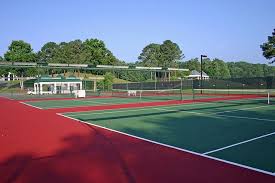There are several materials used for tennis court marking. You can apply some of these materials by hand, whilst the others require certain line marking equipment. Here are 5 of the most common materials used for the tennis court marking:
1. Powder/Chalk
Powder or chalk is used to create a temporary line on the tennis court. This serves as a guide before the taping and painting process can begin. Frequently used on grass tennis court surfaces, powder can be applied using a dry line marker. Alternatively, it can also be combined with a liquid substance so that it can be applied using a spray marker or a wheel marker.
2. Tape
A tape is one of the most common marking materials. Usually laid above the temporary chalk lines, a tape liner or tape machine is also used to apply parallel masking tape with different widths. You can also permanently secure a specific type of tape to the tennis court using screws or tacks. This is usually done on clay tennis court surfaces.
Note: The tape should match the width of the tape liner.
3. Paint
Paint is applied between the tape lines. Some of the most common tools used for painting include a paint brush, roller and sponge. Make sure that the paint is dry before pulling off the tape to prevent line imperfections.
4. Aerosol
Aerosol is a substance (under pressure) placed in a dispensing system that is discharged as a fine spray. This material is used on grass and solid surfaces. It can be applied by hand or with an aerosol applicator.
5. Other Liquids
There are emulsions, water-based paints and other types of liquids that can be used to mark a tennis court. Applied on grass and artificial tennis court surfaces, these liquids typically come in a concentrated and a “ready-to-use” product. Spray markers and transfer wheel markers are commonly used to in their application.
If you want a hassle-free tennis court marking service, Dragon Courts is the specialist you can trust. For more information, you can visit our website or contact us on 01572 770404.









 2. Spray the whole area with weed and grass killer to prevent future growth underneath the synthetic court. Unforeseen growth of grass and weeds may cause damage to the court by creating holes from the base. By laying a ground cloth or weed control fabric you can also help to prevent further growth. Ensure you use an accurate measurement, so it will not overlap with the court.
2. Spray the whole area with weed and grass killer to prevent future growth underneath the synthetic court. Unforeseen growth of grass and weeds may cause damage to the court by creating holes from the base. By laying a ground cloth or weed control fabric you can also help to prevent further growth. Ensure you use an accurate measurement, so it will not overlap with the court.


